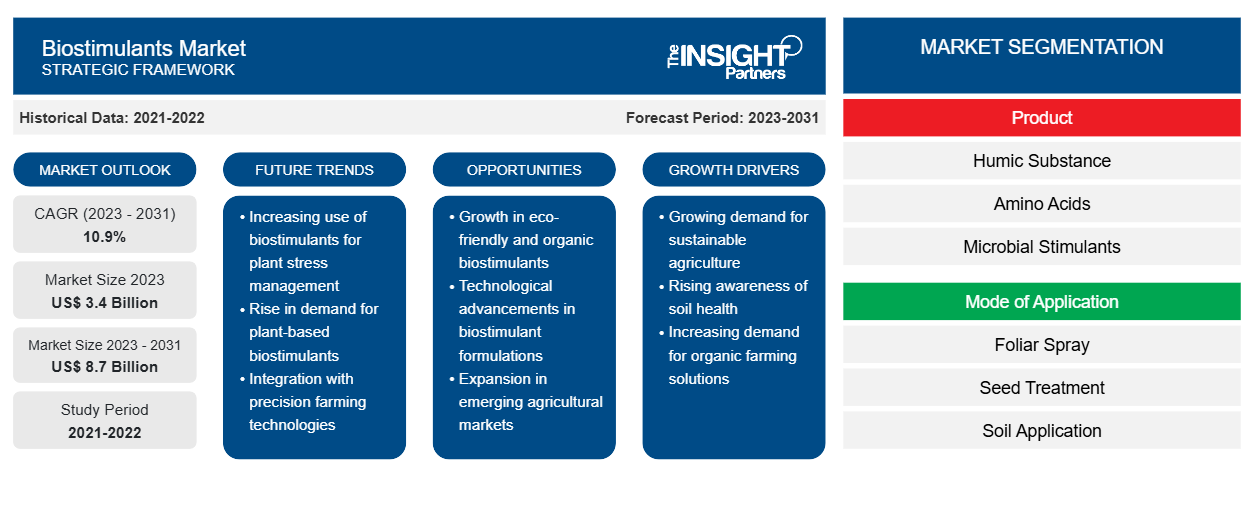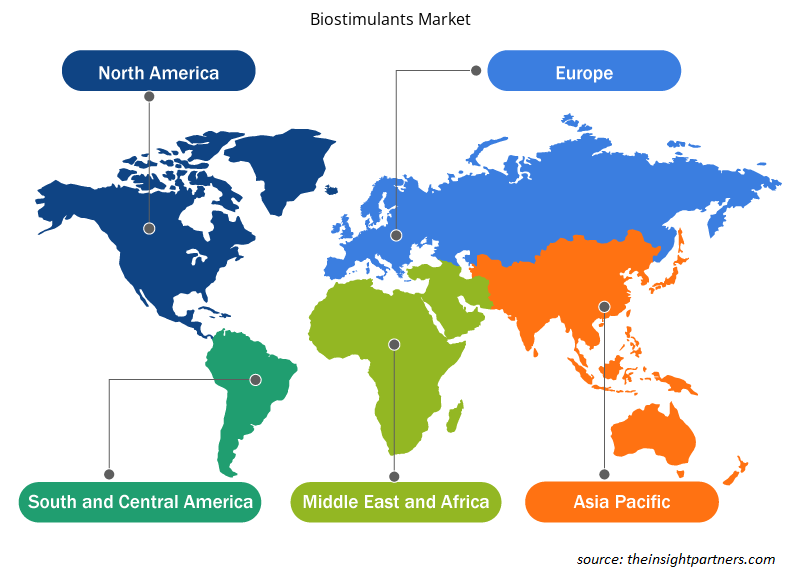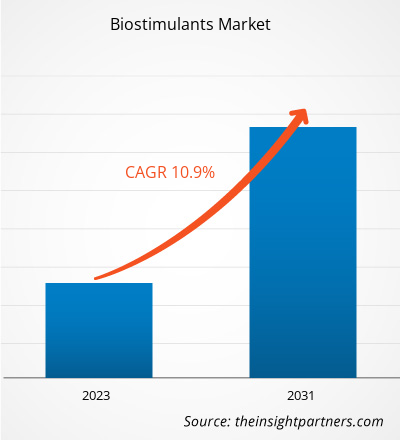Der Markt für Biostimulanzien wird voraussichtlich bis 2031 ein Volumen von 8,41 Milliarden US-Dollar erreichen, ausgehend von 5,55 Milliarden US-Dollar im Jahr 2024. Für den Zeitraum 2025–2031 wird eine durchschnittliche jährliche Wachstumsrate (CAGR) von 6,3 % erwartet. Der wachsende technologische Fortschritt in der Entwicklung von Biostimulanzien dürfte im Prognosezeitraum neue Markttrends schaffen.
Marktanalyse für Biostimulanzien
Biostimulanzien haben aufgrund der Umstellung auf ökologischen Landbau und der Kombination von Biostimulanzien mit chemischen Düngemitteln an Popularität gewonnen. Sie sind beliebte Wachstumsstimulanzien für Pflanzen und helfen, die Wurzelbiomasse, die Nährstoffaufnahme und die enzymatischen Aktivitäten zu stärken. Dies hat die wichtigsten Akteure dazu veranlasst, ihre Produktionskapazitäten deutlich zu steigern. Biostimulanzien, die reich an Mineralien, Pflanzenhormonen und Aminosäuren sind, ermutigen Landwirte, sich für solche Produkte zu entscheiden. Biostimulanzien sind Produkte, die die Ernährungsprozesse einer Pflanze unabhängig von ihrem Nährstoffgehalt verbessern. Diese Biostimulanzien können als Huminstoffe, Aminosäuren, mikrobielle Stimulanzien, Algenextrakte und mehr eingesetzt werden. Sie werden für Getreide und Körner, Ölsaaten und Hülsenfrüchte, Obst und Gemüse, Rasen und Landschaftsbau usw. verwendet.
Marktübersicht für Biostimulanzien
Biostimulanzien sind eine Mischung von Substanzen oder Mikroorganismen, die zur Verbesserung der Erntebedingungen beitragen, ohne die Umwelt negativ zu beeinflussen. Verschiedene Studien haben gezeigt, dass Biostimulanzien als Düngemittelzusatz eingesetzt werden können, was zur Reduzierung des Düngemitteleinsatzes beiträgt. Sie können außerdem die Nährstoffaufnahme, das Pflanzenwachstum und die Toleranz gegenüber abiotischem Stress fördern. Sie unterstützen die Stoffwechselprozesse der Pflanzen, die die Aufnahme essentieller Nährstoffe fördern. Biostimulanzien stehen in verschiedenen Anwendungsmethoden zur Verfügung. Sie können in Form von Pulver, Granulat oder als flüssiges Blattprodukt zur Bodenvorbereitung eingesetzt werden. Der globale Biostimulanzienmarkt ist nach Produkt, Anwendungsart und Pflanzenart segmentiert.
Passen Sie diesen Bericht Ihren Anforderungen an
Sie erhalten kostenlos Anpassungen an jedem Bericht, einschließlich Teilen dieses Berichts oder einer Analyse auf Länderebene, eines Excel-Datenpakets sowie tolle Angebote und Rabatte für Start-ups und Universitäten
Markt für Biostimulanzien: Strategische Einblicke

-
Informieren Sie sich über die wichtigsten Markttrends in diesem Bericht.Dieses KOSTENLOSE Beispiel umfasst Datenanalysen, von Markttrends bis hin zu Schätzungen und Prognosen.
Markttreiber und Chancen für Biostimulanzien
Günstige Regierungspolitik und -initiativen
Die Europäische Union hat die Einführung von Biostimulanzien durch regulatorische Rahmenbedingungen unterstützt, die ihren sicheren und wirksamen Einsatz in der Landwirtschaft gewährleisten. Die Europäische Union hat klare regulatorische Rahmenbedingungen zur Regelung der Verwendung von Biostimulanzien geschaffen. Die EU-Verordnung 1107/2009 (die Pflanzenschutzmittel abdeckt) und die neuere Verordnung (EU) 2019/1009 über Biostimulanzien bieten klare Richtlinien für Biostimulanzien und gewährleisten deren Sicherheit und Wirksamkeit. Diese regulatorische Klarheit hat zu einer stärkeren Einführung von Biostimulanzien durch Landwirte in ganz Europa geführt. Darüber hinaus priorisiert der europäische Green Deal mit seiner Strategie „Vom Hof auf den Tisch“ eine verbesserte Ressourceneffizienz, eine saubere Kreislaufwirtschaft, die Wiederherstellung der biologischen Vielfalt und die Reduzierung der Umweltverschmutzung. Dieser Schritt in Richtung Nachhaltigkeitsziele treibt die Nachfrage nach umweltfreundlichen landwirtschaftlichen Produkten, einschließlich Biostimulanzien, an, um das Ziel zu erreichen, Europa bis 2050 zur ersten klimaneutralen Region zu machen.
Darüber hinaus ermutigen Subventionen, Zuschüsse und Steueranreize Landwirte, umweltfreundliche Alternativen zu nutzen. Nationale Programme wie das indische Paramparagat Krishi Vikas Yojana (PKVY) und die Organic Transition Initiative des US-Landwirtschaftsministeriums (USDA) unterstützen den ökologischen Landbau und steigern indirekt die Nachfrage nach Biostimulanzien. Regierungen fördern zudem Forschung und Entwicklung im Bereich biobasierter Agrarlösungen, was das Branchenwachstum und das Bewusstsein der Landwirte weiter beschleunigt. Diese Maßnahmen stehen im Einklang mit globalen Nachhaltigkeitszielen und stärken die Rolle von Biostimulanzien als Schlüsselinstrument einer klimafreundlichen Landwirtschaft.
Integration von Biostimulanzien mit chemischen Düngemitteln
Der hohe Einsatz chemischer Düngemittel beeinträchtigt Gewässer. Nährstoffe werden von landwirtschaftlichen Betrieben ausgewaschen und gelangen in nahegelegene Flüsse, Seen und Teiche, was zu Eutrophierung führt. Zudem weisen chemische Düngemittel eine geringe Nutzungseffizienz auf. Das bedeutet, dass Pflanzen nur eine Nährstoffmischung aus dem Dünger aufnehmen. Beispielsweise fallen essentielle Nährstoffe wie Phosphor nach der Zugabe in den Boden aus und sind somit weniger pflanzenverfügbar. Auch Stickstoff, ein weiterer essentieller Nährstoff, kann aufgrund von Faktoren wie Nitratauswaschung nicht mehr verfügbar sein.
Durch die Kombination von Biostimulanzien mit chemischen Düngemitteln lässt sich nachhaltiges Ressourcenmanagement erreichen, da es die Nährstoffaufnahme optimiert, ein robustes Pflanzenwachstum fördert und möglicherweise die Abhängigkeit von synthetischen Düngemitteln reduziert. Diese Strategie kann auch die Umweltverschmutzung durch übermäßigen Düngemitteleinsatz verringern. Biostimulanzien erfordern zwar im Vergleich zu bestimmten herkömmlichen chemischen Düngemitteln höhere Anfangsinvestitionen, ihre agronomischen und wirtschaftlichen Vorteile – wie höhere Erträge und bessere Gewinne für die Landwirte – können jedoch langfristig eine höhere Kapitalrendite erzielen. So ergab beispielsweise eine im Italian Journal of Agronomy veröffentlichte Studie über Hartweizen, dass die Anwendung von Biostimulanzien wichtige morphophysiologische Parameter und den Kornertrag erheblich steigern und gleichzeitig die Abhängigkeit von synthetischen Stickstoffdüngern reduzieren kann. Die oben genannten Vorteile dürften daher die Nutzung von Biostimulanzien fördern und somit das Wachstum des Biostimulanzienmarktes in den kommenden Jahren vorantreiben.
Segmentierungsanalyse des Marktberichts für Biostimulanzien
Wichtige Segmente, die zur Ableitung der Marktanalyse für Biostimulanzien beigetragen haben, sind Produkttyp, Anwendungsart und Pflanzenart.
- Basierend auf dem Produkttyp ist der Markt für Biostimulanzien in Huminstoffe, Aminosäuren, mikrobielle Stimulanzien, Algenextrakte und weitere Produkte segmentiert. Das Segment Algenextrakte hielt im Jahr 2024 den größten Anteil am globalen Markt für Biostimulanzien.
- Nach Anwendungsart ist der Markt für Biostimulanzien in Blattspray, Saatgutbehandlung und Bodenanwendung unterteilt. Das Segment Blattspray hatte im Jahr 2024 den größten Anteil am Biostimulanzienmarkt.
- Der Markt für Biostimulanzien ist nach Anbauarten in Getreide, Ölsaaten und Hülsenfrüchte, Obst und Gemüse, Rasen und Landschaftsbau sowie weitere Produkte unterteilt. Das Segment Getreide hatte im Jahr 2024 den größten Anteil am Markt für Biostimulanzien.
Biostimulanzien Marktanteilsanalyse nach Geografie
Der geografische Umfang des Biostimulanzien-Marktberichts ist in fünf Regionen unterteilt: Nordamerika, Asien-Pazifik, Europa, Naher Osten und Afrika sowie Süd- und Mittelamerika. Der Biostimulanzien-Markt im asiatisch-pazifischen Raum wird im Prognosezeitraum voraussichtlich deutlich wachsen.
Der Markt für Biostimulanzien im asiatisch-pazifischen Raum ist aufgrund des wachsenden Bewusstseins der Landwirte und der steigenden Nachfrage nach Lebensmitteln aufgrund der wachsenden Bevölkerung von großer Bedeutung. Die steigende Nachfrage nach Agrarprodukten und der wachsende Bedarf an Bioprodukten dürften den Verbrauch von Biostimulanzien im asiatisch-pazifischen Raum, insbesondere in China, Japan und Indien, ankurbeln. Aufgrund ihres wettbewerbsintensiven und wachsenden Agrarsektors weisen diese asiatischen Länder einen hohen Produktverbrauch auf. Hersteller in verschiedenen asiatisch-pazifischen Ländern entwickeln einzigartige Produkte mit überlegener Wirksamkeit und geringer Toxizität. So erhielt beispielsweise das indische Start-up-Unternehmen Sea6 Energy aus Bengaluru im Jahr 2021 das erste Patent des Landes auf ein Biostimulanzienprodukt. Das Unternehmen verfügt außerdem über zahlreiche exklusive Produkte aus Rotalgen.
Da sich Verbraucher zunehmend der gesundheitlichen Vorteile einer gesunden Ernährung bewusst werden, steigt die Beliebtheit von Bio-Lebensmitteln. Dieses Bewusstsein führt zu einem zunehmenden Einsatz von Biodünger und ersetzt konventionelle Anbaumethoden, die stark auf chemische Düngemittel angewiesen sind. Biostimulanzien spielen eine wesentliche Rolle bei der Verbesserung der Nährstoffeffizienz und der abiotischen Stresstoleranz. Daher wird erwartet, dass die Nachfrage nach Biostimulanzien im Biolandbau den Markt in der Region ankurbeln wird.
Regionale Einblicke in den Markt für Biostimulanzien
Die Analysten von Insight Partners haben die regionalen Trends und Faktoren, die den Biostimulanzienmarkt im Prognosezeitraum beeinflussen, ausführlich erläutert. In diesem Abschnitt werden auch die Marktsegmente und die geografische Lage von Biostimulanzien in Nordamerika, Europa, Asien-Pazifik, dem Nahen Osten und Afrika sowie Süd- und Mittelamerika erörtert.

- Erhalten Sie regionale Daten zum Biostimulanzienmarkt
Umfang des Marktberichts über Biostimulanzien
| Berichtsattribut | Details |
|---|---|
| Marktgröße im Jahr 2024 | 5,5 Milliarden US-Dollar |
| Marktgröße bis 2031 | 8,41 Milliarden US-Dollar |
| Globale CAGR (2025 – 2031) | 6,3 % |
| Historische Daten | 2021-2023 |
| Prognosezeitraum | 2025–2031 |
| Abgedeckte Segmente |
Nach Produkttyp
|
| Abgedeckte Regionen und Länder |
Nordamerika
|
| Marktführer und wichtige Unternehmensprofile |
|
Marktteilnehmerdichte für Biostimulanzien: Auswirkungen auf die Geschäftsdynamik
Der Markt für Biostimulanzien wächst rasant. Die steigende Endverbrauchernachfrage ist auf Faktoren wie veränderte Verbraucherpräferenzen, technologische Fortschritte und ein stärkeres Bewusstsein für die Produktvorteile zurückzuführen. Mit der steigenden Nachfrage erweitern Unternehmen ihr Angebot, entwickeln Innovationen, um den Verbraucherbedürfnissen gerecht zu werden, und nutzen neue Trends, was das Marktwachstum weiter ankurbelt.
Die Marktteilnehmerdichte beschreibt die Verteilung der in einem bestimmten Markt oder einer bestimmten Branche tätigen Unternehmen. Sie gibt an, wie viele Wettbewerber (Marktteilnehmer) in einem bestimmten Marktraum im Verhältnis zu dessen Größe oder Gesamtmarktwert präsent sind.
Die wichtigsten Unternehmen auf dem Markt für Biostimulanzien sind:
- BASF SE
- UPL Limited
- Valagro
- Gowan Company
- FMC Corporation
- ILSA SpA
Haftungsausschluss : Die oben aufgeführten Unternehmen sind nicht in einer bestimmten Reihenfolge aufgeführt.

- Überblick über die wichtigsten Akteure auf dem Markt für Biostimulanzien
Neuigkeiten und aktuelle Entwicklungen zum Biostimulanzienmarkt
Der Markt für Biostimulanzien wird durch die Erhebung qualitativer und quantitativer Daten aus Primär- und Sekundärforschung bewertet. Dazu zählen wichtige Unternehmenspublikationen, Verbandsdaten und Datenbanken. Einige der wichtigsten Entwicklungen im Markt für Biostimulanzien sind:
- UPL AgroSolutions Canada hat sein Biostimulans Wave nach der Registrierung durch die kanadische Lebensmittelbehörde (Canadian Food Inspection Agency) in Kanada auf den Markt gebracht. (Quelle: UPL Ltd, Pressemitteilung, Januar 2023)
- Die Biostimulanzien-Technologie von IntraCrop wurde in der tschechischen Ausgabe von National Geographic vorgestellt und steigert die Ernteerträge bei reduziertem Düngemitteleinsatz um bis zu 15 %. (Quelle: IntraCrop, Pressemitteilung, November 2024)
Marktbericht zu Biostimulanzien: Umfang und Ergebnisse
Der Bericht „Marktgröße und Prognose für Biostimulanzien (2021–2031)“ bietet eine detaillierte Analyse des Marktes, die die folgenden Bereiche abdeckt:
- Marktgröße und Prognose für Biostimulanzien auf globaler, regionaler und Länderebene für alle wichtigen Marktsegmente, die im Rahmen des Berichts abgedeckt sind
- Markttrends für Biostimulanzien sowie Marktdynamiken wie Treiber, Einschränkungen und wichtige Chancen
- Detaillierte Porter's Five Forces und SWOT-Analyse
- Marktanalyse für Biostimulanzien mit wichtigen Markttrends, globalen und regionalen Rahmenbedingungen, wichtigen Akteuren, Vorschriften und aktuellen Marktentwicklungen
- Branchenlandschafts- und Wettbewerbsanalyse mit Marktkonzentration, Heatmap-Analyse, prominenten Akteuren und jüngsten Entwicklungen auf dem Markt für Biostimulanzien
- Detaillierte Firmenprofile
- Historische Analyse (2 Jahre), Basisjahr, Prognose (7 Jahre) mit CAGR
- PEST- und SWOT-Analyse
- Marktgröße Wert/Volumen – Global, Regional, Land
- Branchen- und Wettbewerbslandschaft
- Excel-Datensatz
Aktuelle Berichte
Verwandte Berichte
Erfahrungsberichte
Grund zum Kauf
- Fundierte Entscheidungsfindung
- Marktdynamik verstehen
- Wettbewerbsanalyse
- Kundeneinblicke
- Marktprognosen
- Risikominimierung
- Strategische Planung
- Investitionsbegründung
- Identifizierung neuer Märkte
- Verbesserung von Marketingstrategien
- Steigerung der Betriebseffizienz
- Anpassung an regulatorische Trends






















 Kostenlose Probe anfordern für - Markt für Biostimulanzien
Kostenlose Probe anfordern für - Markt für Biostimulanzien